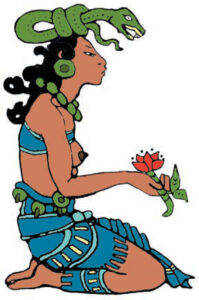How an ancient technique can prepare your body for conception and ease menstrual cramps
by Catherine S. Gregory.
 From the onset of puberty through menopause, women are given a sacred reminder of our powerful creative force: the monthly !ow from our wombs. Yet all too often in our culture, we don’t see menstruation as sacred at all. Instead, we dread it. I used to frequently complain about my menstrual cycles; through years of painful cramps, ovarian cysts, headaches, back pain, and digestive disturbances, I just couldn’t find the joy in celebrating this mark of my womanhood. But after my encounter with a Mayan shaman in Mexico, that all changed.
From the onset of puberty through menopause, women are given a sacred reminder of our powerful creative force: the monthly !ow from our wombs. Yet all too often in our culture, we don’t see menstruation as sacred at all. Instead, we dread it. I used to frequently complain about my menstrual cycles; through years of painful cramps, ovarian cysts, headaches, back pain, and digestive disturbances, I just couldn’t find the joy in celebrating this mark of my womanhood. But after my encounter with a Mayan shaman in Mexico, that all changed.
I was in the Yucatán, attending a yoga retreat, when I booked a traditional healing massage with a local Mayan healer. I had no expectations beforehand, just a desire to unwind and rejuvenate my body, mind, and spirit. What unfolded in that two-hour massage was the most blissful, powerful healing experience of my life. As the shaman’s hands moved rhythmically across my body, he quietly chanted prayers in Mayan, intuitively melting my tensions along the way. He began to work deeply around my navel and lower abdomen. As I relaxed into it, I was suspended in a state of timelessness, cooled by the light breeze coming through the beachside palapa. He blew into my navel and continued chanting his prayers. A white light engulfed me. I opened my eyes to see if the bright tropical sun had somehow penetrated the shaded room, but it was dark. I closed my eyes again. The light returned.
In our conversation afterward, I asked the sha-man about the work he’d done on my abdomen. Looking into my eyes as he spoke to me in Mayan, he told me, through a translator, that women often sought his help when they had difficulty conceiv-ing a child, and that I would no longer have such problems. But how did he know about my fertil-ity issues? I hadn’t mentioned a word about my menstrual difficulties, or my years of never getting pregnant while not using birth control.
A week later, I returned home to a loving reunion with my soon-to-be husband. During our lovemaking, I was once again engulfed by white light. Maybe it was a lucky coincidence, but just weeks after this experience, we discov-ered that we had conceived a baby.
As our daughter grew inside me, I was com-pelled to learn more about traditional Mayan healing. I learned that the work the shaman had done on my abdomen and pelvis was an ancient form of Mayan uterine massage—a gentle, external technique used to return the uterus to its proper position within the pelvis. I looked into it more, and eventually found Dr. Rosita Arvigo, of Belize, who was traveling to the US to train practitioners in this ancient modality. Arvigo had apprenticed for ten years with Don Elijio Panti, a renowned Mayan shaman from Belize, to master the same ancient technique I’d experienced in Mexico.
Learning more about the importance of a properly positioned uterus, I began to question many things my doctors had told me about the health of my reproductive system. Since my early 20s, I’d heard from a string of gynecolo-gists that I had a “tipped” (retroverted) uterus. My cervix faced back toward my spine, making for very uncomfortable exams and Pap smears. I’d probed my doctors for more information: What caused this? Will it affect my ability to become pregnant? Is there anything I can do about it? All of my questions were answered with similar reassurances: Nothing to worry about, Catherine. A tipped uterus is simply a variation of normal. Lots of women have this.
Yet after stumbling on Arvigo’s website, I learned that a tipped uterus is often the cause of a long list of female complaints, including many of the symptoms I’d suffered over the years. Although none of my doctors had ever associated my problems with the position of my uterus, with just a basic understanding of pelvic anatomy I could now see the connection: A slew of seemingly unrelated symptoms can be attributed to a malpositioned uterus because of the organ’s close proximity to the colon, small intestine, and bladder, as well as to the nerves and blood vessels that supply these organs through the lower spine and sacrum.
Arvigo explained to me that the longer the uterus is out of place, the more the muscula-ture and connective tissue can tighten around it, increasing pelvic congestion and stagnation inside the womb. The restricted flow to the uterus of blood, nerve impulses, lymphatic fluid, and energy can lead to painful cramps, the dete-rioration of the uterine lining, hormonal imbal-ance, and problems with fertility. The longer the stagnation lasts, the greater the possibility for more complicated symptoms to arise, including ovarian cysts, endometriosis, fibroids, and, pos-sibly, uterine and ovarian cancers.
After her decade with Panti, Arvigo knew that she wanted to share this simple yet essential heal-ing technique with women around the world, and 14 years ago she developed her protocol, the Arvigo Techniques of Maya Abdominal Massage.
These combine the ancient Mayan massage she’d learned from Panti with a number of different bodywork techniques, herbal therapies, and dietary and lifestyle changes culled from her earlier trainings in other healing modalities… Read the full article